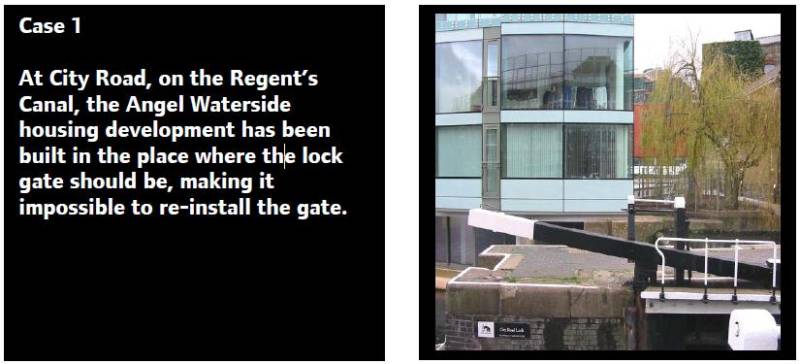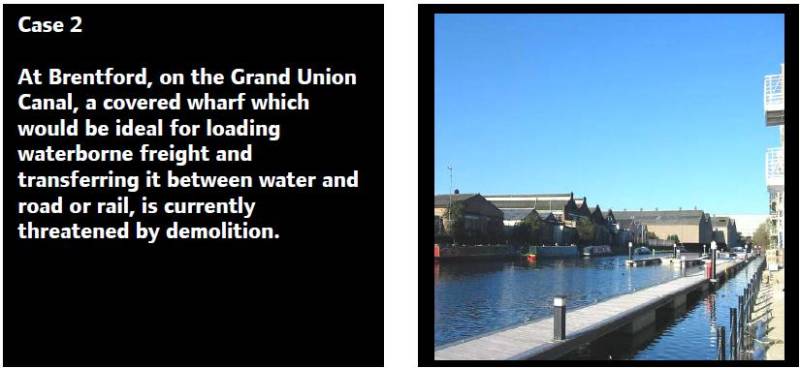Deserted Highways
London’s waterways are a neglected and wasted resource
A report by the Green Party Group on the London Assembly. December 2004


“London’s canals are a wasted resource. There is potential for moving millions of tonnes of freight by canal and reducing lorry traffic through London. But many parts of the canal network carry no freight traffic at all. This has to change. London’s canals must be put to work again.” Jenny Jones, Green Party Member of the London Assembly
This report outlines the current use of London’s
canals and identifies threats to their well-being. It calls for a major
transfer of freight from the capital’s roads to its canals. This
would lead to a dramatic reduction in lorry traffic, cleaner air, safer
streets and increased funding for the support and improvement of the
canal network, its towpaths and surroundings.
Facts on London’s Waterways Network:

Who runs and funds London’s canals?
London’s canals are managed by British Waterways, for leisure, conservation and transport. The funding comes from licensing and mooring fees, other earnings (for example for water services, cabling under towpaths, a property portfolio and rental income) and third party sources (such as planning gain and lottery funding). Last year London’s canals received no direct funding from the government.The government expects British Waterways to raise funds from its assets, including the development of canalside land. This development generates funds to invest in the canal network. But in some places the loss of canalside land to housing directly conflicts with the use of canals for freight transport and the use of adjacent land for operational purposes, such as wharves, warehouses, boatyards, waste management, recycling and reprocessing facilities.
British Waterways has carried out many improvements to London canals in recent years. However funding is too little and too uncertain to pay for the major comprehensive overhaul which is now urgently needed if full use is to be made of the canal network for transport of heavy and bulky goods, especially waste and building materials, as well as for recreation and wildlife.

Current usage of London’s canals
Here are some examples of the important roles which the canals can play in London.- 60,000 tonnes of sand and gravel per year are being shipped along the Grand Union Canal from a pit at Denham to West Drayton in Hillingdon. Planned to last seven years, this is removing over 5,000 lorry journeys a year from a 5.5 mile stretch of road (Note 4).
- The recently approved plan for a waste and recycling centre at Old Oak Railway Sidings, Willesden Junction, will unlock the potential of West London’s canals. The plan includes a new wharf on the Grand Union Canal to allow waste and materials to be brought in and out by water, taking over 100,000 lorry journeys off West London’s roads, and allowing transfer between canal and rail.
- In Hackney, the proposed “waste by water” scheme could result in domestic waste being transferred from road to the Lee Navigation – reducing lorry miles from 124,000 to 45,000 a year (Note 5). However, this scheme is under threat and needs a political boost if it is to happen.
- 12,000 tonnes, or 1,500 lorry-loads worth, of waste scrap by-product, which currently travels 12 – 15 miles from Edmonton to Canning Town by road, could be transported by boat on the Lee Navigation, according to the Freight Study Group (Note 7).
- The canals provide many opportunities for recreation, which in turn help to maximise their social, economic and environmental potential by providing natural surveillance and moving the water, thereby preventing stagnation. These already include boat trips between Camden and Little Venice, the Canal Museum in Islington, the Hanwell flight of locks, the Pirates project at Camden (with boating activities for young people and families), the Islington and Laburnum boat clubs, other canoeing clubs, narrow boats, rambling, fishing, exploring wildlife, and Thames21’s thriving canal-based volunteer projects. An imaginative proposal for the future is a leisure waterbus serving a six mile ring from Limehouse Basin, along Limehouse Cut, the Lee, Hertford Union Canal and Regent’s Canal back to the Basin.
- Many stretches of towpath are accessible to walkers and cyclists. Other stretches need to be opened up, signed and maintained. For example, funding is required to provide for cycling on the Grand Union Canal between Paddington and Greenford, and between Brentford and Hayes (Note 8). Such ‘Green Corridors’ open up central London and provide safe alternatives to cycling and walking on roads.
Threats to the well-being of London’s canals
London’s canal network remains hugely underused for navigation. In some places the canals are empty waterways, silted up and unattractive havens for old tyres. Some redevelopment schemes on the canals will actually prevent the canal network being used fully for transport and recreation.

“There are already many inspiring examples showing
how London’s canals can be brought back to life. We must take
this vision forward and make London’s whole canal network fully
operational for transport, whilst protecting nature and leisure
activity,” Darren Johnson, Green Party member of the London
Assembly.
Obstacles to a canal revival
Lack of a strategic advisory body for all London’s waterways
There is duplication and overlap between the Thames and Waterways Steering Group and the London Canals Committee, both of which are dormant, leaving an absence of strategic policy making and expert advice.Conflicting interests for British Waterways
British Waterways is responsible for both promoting navigation on the canals and for raising funds for the canals from development of its property. These two roles can conflict and undermine opportunities to increase waterborne transport.Funding
British Waterways’ funds are limited. Funds from other sources (e.g. the government’s Freight Facilities Grant and Transport for London) are too small and too uncertain to refit London’s canal network for modern navigation. Funds are needed to dredge to greater depth, automate and improve locks, and develop more wharves in the right place.Weak planning controls
The Blue Ribbon Network policy in the London Plan is an important step forward in protecting London’s canals for water-based uses, but it still does not give sufficient priority to navigation on the waterways network. London faces huge development pressure and waterside sites are especially attractive for housing development. Even with the Blue Ribbon Network planning policy, wharves, warehouses, boatyards and waterspace are being lost to housing and other development.Lack of incentives and help to switch freight from road to canal
Transport of freight by water is not promoted actively to potential customers. Advice and technical assistance is hard to obtain. Without financial incentives it is unlikely that many freight handlers will overcomes these barriers.Lack of integration with rest of London’s transport network
The waterways network is managed by British Waterways without a formal connection to Transport for London. This makes it hard to plan for transfer of freight between water, road and rail, and the development of passenger services.
Recommendations for London’s canals
- A Blue Ribbon Network Agency should be set up by the London Mayor to be a strategic body for all London’s waterways, resourced from the Greater London Authority, and chaired by a London waterways champion.
- The London Mayor, Transport for London and British Waterways must develop a joint action plan to increase waterborne transport of freight.
- Larger and more certain funding streams should be identified to improve and maintain canals for navigation, improve and maintain towpaths, enhance wildlife and, where possible, facilitate cycling. Jenny showing Mayor’s Advisor Neale Coleman the potential of London’s canals.
- Financial incentives should be available for waterborne freight. A feasibility study should assess practicality and the level of subsidy.
- All development benefiting from proximity to canals should contribute to a “London Waterways Fund”, whether through Section 106 planning gain agreements or other mechanisms. Business Improvement District grants from canalside districts should also contribute to the fund.
- There should be an action plan for each canal route, including specific proposals for transport use.
- Waste contracts for boroughs on the waterways network should not be approved unless the contracts require substantial use of waterways for carrying waste and recycling. The pilot “waste by water” scheme in Hackney needs financial support.
- All developments on the canals, including supermarkets, should have a recycling station with canal access for shipment.
- A range of major transport projects and mixed use developments, located on the canal network, are either already underway or planned. These schemes should be required to make use of waterways for the transport of construction materials, waste and tunnel spoil. They include the Kings Cross redevelopment, Crossrail and the supersewer tunnels, and the Olympics/Lower Lea Valley development.
- Restoration of the Bow Back Rivers should be a priority.

Endnotes
1. British Waterways London, Fact File2. Guardian, 5 August 2004
3. London Biodiversity Partnership
4. Freight on Water – a New Perspective, report of the Inland Waterways Freight Study Group, 2002
5. As above
6. West London Canal Network study, 2004
7. Freight on Water – a New Perspective, as above
8. London’s Green Spaces – Under-used Assets, London Cycling Campaign
Recent Publications by the Green Party Member of the London Assembly
Farmers Markets – Reconnecting Londons farmers and shoppersAllotments - Has London lost the plot?
Bobbies on Bikes - Use of mountain bikes by the Metropolitan Police
Keep off the Grass- The loss of London’s playing fields
Plastic not Fantastic- Why plastic bags are bad
Toilets going to Waste- London’s public toilets are being flushed away
Chainstore Massacre - A recipe for revival of strong independent shops.
Increase in Gun Crime – calling for a ban on sale of replica guns
What a Pane – selling of illegal single pane replacement windows
Traffic Free Parks – closing roads to motor traffic in parks
Nuclear Free London – working for peace and security from nuclear hazards
Contact Information
General enquiriesTel 020 7983 4411
E-mail greenpartygroup@london.gov.uk
Media enquiries
Tel 020 7983 4424 or 07795 616812
London Assembly members Email: Darren.Johnson@London.gov.uk
Tel: 020 7983 4406
Email: Jenny.Jones@london.gov.uk
Tel: 020 7983 4358
Address
London Assembly Green Party Members
City Hall
London SE1 2AA
www.london.gov.uk
This report is also available in PDF format.
